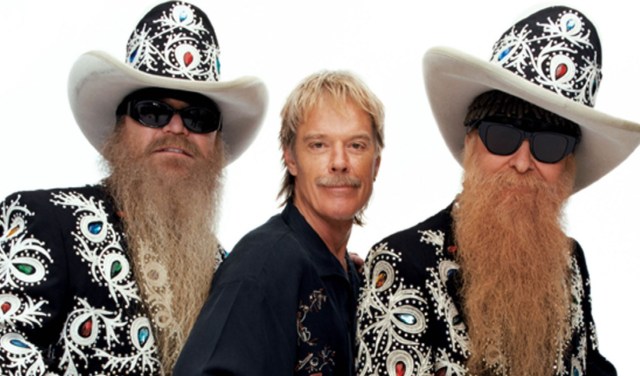
It’s not the most diverse musical genre, in its performers or in its fan base. But as “classic rock” finally starts to age its way into geezer biker bars and becomes the genuine “oldies radio” of today, it’s high time we paid tribute to the bands and artists that became synonymous with that label.
An Oscar winning Queen film here, an Elton John songbook and possible Oscar contending bio-pic there.
And here’s a tribute to the longest-lived, at least in terms of maintaining the same lineup, of them all.
The nickname “That Little Ol’Band from Texas” probably started life as a put-down, another way of ridiculing good ol’boys playing boogie blues as “party music” in Nudie suits, boots and cowboy hats. But here they are, ZZ Top, turning 50, still touring, still comprised of Frank Beard on drums, Dusty Hill singing and playing bass and Billy F. Gibbons, America’s answer to Clapton, on guitar and vocals.
“ZZ Top: That Little Ol’Band from Texas” is a straight, no-chaser band biography documentary, lacking flash and big name peers singing their praises and expert testimony to park them in their rightful place in music history.
Sure, Billy Bob Thornton’s a fan, and Steve Miller, Josh Homme (Queens of the Stone Age) and Dan Auerbach (The Black Keys) are here. But they’ll have to do, because those who inducted them into the Rock and Roll Hall of Fame, the performers that plucked them to be opening acts giving them early breaks (Jeff Beck, The Rolling Stones, Hendrix) are mostly gone or simply unavailable for this little tribute film.
It doesn’t really matter. The recording engineers who found their fat sound, a publicist who helped them gain respectability and build their brand and a few others help the trio tell their story, from Texas obscurity in the ’60s to MTV immortality by the 80s, still playing stadiums as they enter their 70s.
Hardcore fans will know much of what turns up here — the Dallas to Houston move that linked the three of them up, the performers that inspired that “power trio” lineup (Cream, The Jimi Hendrix Experience).
Did Hendrix really come up and profess admiration for their “nerve,” covering two of his songs while his OPENING act? Did Mick Jagger stand off stage in Honolulu in overalls, holding up a broom as his fake beard, while watching them open for The Stones?
One obvious thing I’d never considered while growing up with this music in the South of the 70s and 80s was “the mystique” Thornton and others speak of.
But from their first album, “Tre Hombres,” hiding their faces and putting the music out front worked. Growing beards just added a mask.
They broke big, and then sealed their brand identity for all time by coming back from a three year hiatus with synthesizer-backed blues, a hot rod logo and gorgeous young women and men “helped” to make love connections by a “cartoon version” of the band.
You didn’t have to ever buy a ZZ Top recording to know who they were, worldwide, Dan Auerbach of The Black Keys says. “It made them cultural icons.”
There’s silent home movie footage of the bands Dusty Hill and his brother started, still photos of early versions of the band Gibbons formed as a play on The 13th Floor Elevators. What’s on the highest floor? The “Top.” What do the great blues performers go by? Initials. B.B., meet “Z.Z.”
The film could have used more archival footage with sound, but when your mastermind manager Bill Ham decrees “no interviews” to build that early mystique, and they weren’t performing on TV, you can see the problem the filmmakers are up against.
Beard regales us with stories as maybe the most cheerful ex-addict we’ve ever met, getting his first big check, “$72,000, and I spent ever’BIT of it on drugs!”
Hill talks about taking a name-tag job as an airport baggage handler AFTER their break-out “Texas World Tour” (livestock on their giant Texas map stage) made them rich in the late ’70s, a working class gig just to get him grounded and clear his head.
And Gibbons, in his urbane drawl, recalls the night they played a show for a single paying customer in Alvin, Texas, for a fan who “still comes around to shows TO THIS DAY.”

The lighthearted tone of the whole affair is set by the wild-eyed Thornton, who marvels that catching them live was like “seeing BUGS BUNNY up there on the stage.”
They recreate the improvised “Blues Shuffle in C” that they jammed to the first time they rehearsed, and do it in the famed Gruene Hall, the oldest music hall in Texas. The “Texas meets Tennessee” traces in their blues-rock songs and the post-hiatus Gibbons infusion of “punk” and then New Wave into their tunes is surveyed.
And those tunes, that magical plucked chord progression that opens “La Grange,” with that rat-a-tat on the drum’s rim underneath it, the thumping, wailing post-disco giggle that made “Give Me All Your Lovin'” fodder for one of the stand-out videos in the history of MTV.
A year doesn’t go by when some ZZ Top song or three doesn’t feature in the trailer to an action film.
How’ve they managed to stay on speaking terms, working in harmony for 50 years? Everybody has an answer, but only Beard’s matters.
“I’ve found the people I was meant to play with,” he says. “I never wanted to quit, and never wanted to get fired.”

MPAA Rating: unrated, drug anecdotes, profanity
Cast: Billy Gibbons, Dusty Hill, Frank Beard, Billy Bob Thornton, Steve Miller
Credits: Directed by Sam Dunn. Written by Ralph Chapman and Sam Dunn. An Abramorama release.
Running time: 1:30
